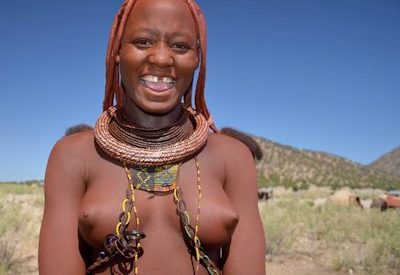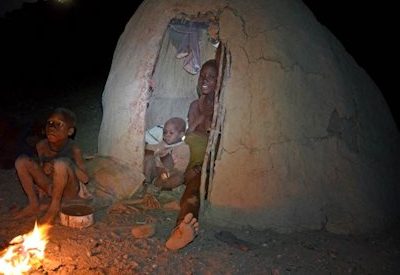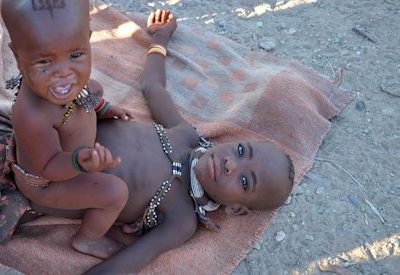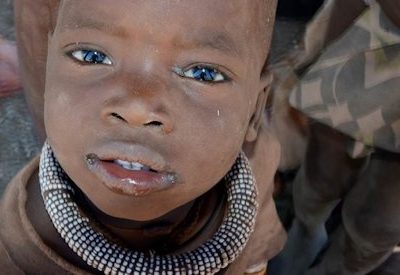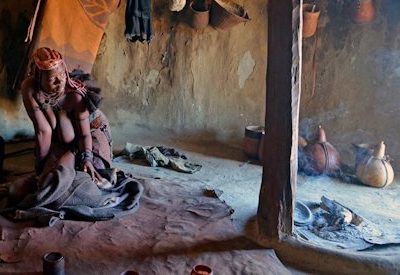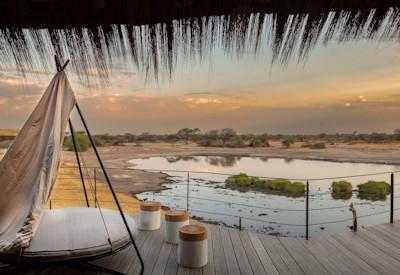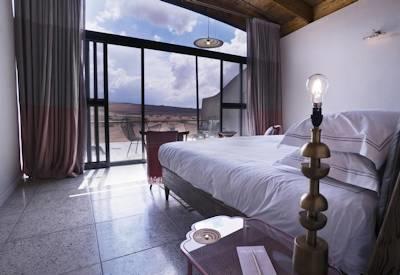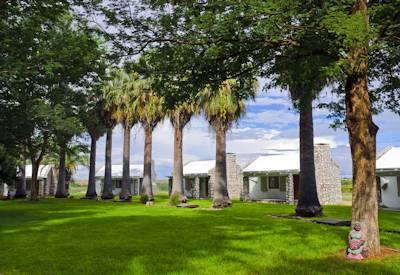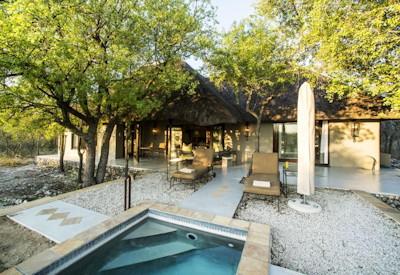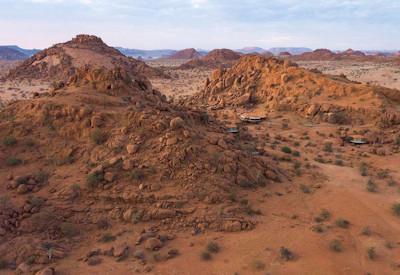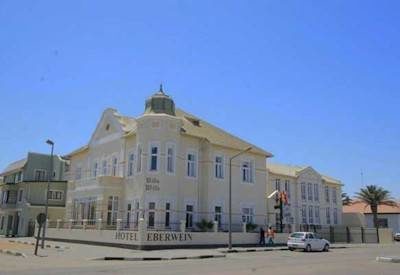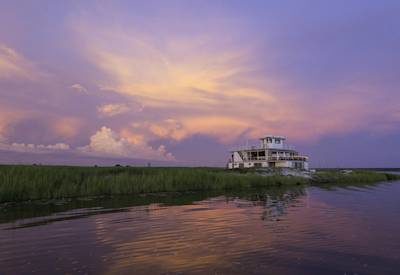In May 2012, we arranged for Uyaphi.Com client Ken Vine from Devon in England to stay with the traditional Himba people in two remote villages in the middle of Kaokoland, Namibia. He lived, slept, ate, conversed and photographed these Himba villagers. He produced a video documentary of his encounter and has given several lectures for charity about his stay with the Himba. In this Q & A interview, we ask Ken about his memories and his experiences.
Uyaphi: What motivated you to stay with the Himba?
KV: I suppose a fascination for people and cultures. Also, I was on holiday in Peru where I met up with a guy from South Africa who told me about the Himba. My interest spread from there and then I found your company on the internet who could arrange such a trip.
Uyaphi: Why did you choose the Himba above other traditional peoples?
KV: Purely by chance, before I met the guy from South Africa, I was interested in spending time with tribes’ people in the Amazon.
Uyaphi: Staying in the village, what were your first impressions?
KV: What a harsh and unforgiving environment to live in. The first Himba I saw were in the frontier town of Opuwo, basically, the last crossroads before the wilderness and they had sort of become westernized.
Uyaphi: Were you welcomed by the villagers or were they suspicious of you?
KV: The first two days they were certainly suspicious of why I was there and I had to sleep outside of the village but then my guide managed to persuade the chief that I was harmless. Then they accepted me with amused tolerance, and then after that, I joined in all of their daily activities. I must say, I never felt threatened and they were very friendly people.
Uyaphi: You slept in a tiny, cow dung rondavel. How was that like?
KV: Very strange sleeping on a cowhide mat. It was so small you couldn’t stand up in it. The lady who lived there cooked outside for me and lit the fire in the evening. The rondavel was much too hot for me in the day so I joined the Himba sitting in the shade. It was fine at night. (Editor’s note: May is approaching winter with hot days but very cold evenings in this arid, semi-desert landscape).
Uyaphi: The villagers seemed to be well-fed and generally happy from the video. Would you say that is a true reflection?
KV: Yes, I would. They are very happy people. They seemed to have plenty of cattle and goats. I think they had good rains earlier in the year. They ate lots of maize cobs and had melons (where they got them from, I don’t know). They were really lovely people. The Namibian government is trying to educate them and bring them more in line with modern society.
Uyaphi: Would you say that the Himba, as a traditional people, are thriving and what would you say are the major threats to their way of life?
KV: Their way of life will diminish more and more. I would be amazed that even in ten years’ time; life will be the same as I saw them. Whether that is a good thing or not, that is not for me to say.
Uyaphi: During the video, there is a clip about them enthusiastically receiving western medicine for their various ailments. Does this reflect disenchantment with their traditional medicines or just interest in trying out new things?
KV: I think they know that certain medicines give instant relief. The older people will be more resistant and stay with their traditional medicines. I was wary of giving them tablets as I didn’t know how it would affect them. The chief who I am sure was suffering from malaria, kept asking me for paracetamol which gave him some temporary relief from his pain. I am sure that traditional medicine will be maintained in some form in the future.
Uyaphi: On reflection, 12 months after your experience, what are your overriding memories?
KV: For me, I didn’t realize how poor they were but it was nice to see people who shared everything. They were not interested in the material world. It doesn’t mean anything to them. They didn’t want anything from me which was unusually nice. As long as they don’t get exploited, I would like to see them get better healthcare and education
Uyaphi: Ken, thank you very much for your time and we wish you good luck with your next adventure in 2014, staying with a remote Maasai people near the Masai Mara Reserve.
KV: Thank you. I am going to Antarctica later in the year and then I look forward to my next African trip.
Ken produced a video of his encounter entitled Living With The Himba and has given a lecture for the Children With Cancer charity of his time with the Himba. If you would like to receive a copy of the DVD, please contact Ken directly at post@vip-design.co.uk
Living With The Himba by Uyaphi.com
Onguma Camp Kala
Nestled on the edge of Namibia's breathtaking Etosha National Park, Onguma Camp Kala offers an unforgettable retreat blending luxury and wilderness. This exclusive Camp is the perfect escape for nature enthusiasts and those seeking tranquillity amidst unspoiled landscapes.
Each stay at Onguma Camp Kala promises a seamless blend of adventure and relaxation. Guests can witness diverse wildlife from the comfort of their private suites or venture out on guided safaris for close encounters with nature.
The Desert Grace
The Desert Grace offers guests a more intimate and luxurious affair with the surrounding desert, making it the perfect base from which to explore the surrounding attractions, including the Namib Nauklauft, Sossusvlei dune, Deadvlei and Sesriem Canyon.
A lodge that offers guests stylish and comfortable accommodation, excellent facilities, passionate guides and a variety of safari activities to enjoy. The Desert Grace will provide an unforgettable experience in the heart of the Namibian desert.
Kalahari Farmhouse
Located in Namibia's Kalahari Desert, Kalahari Farmhouse is a peaceful retreat for those seeking the desert's beauty. Surrounded by red dunes, green gardens, and an oasis-like ambience, it combines rustic charm with modern comfort.
At Kalahari Farmhouse, visitors can enjoy the peaceful rhythms of farm life and warm Namibian hospitality. Explore the manicured gardens, savour fresh local meals, or join a guided Kalahari Desert excursion.
Villa Mushara
Nestled on the edge of Namibia's iconic Etosha National Park, Villa Mushara is a sanctuary of tranquillity and luxury. This exclusive retreat offers guests a unique blend of elegance and wilderness, where the untamed beauty of the African savannah meets the comforts of world-class accommodation.
Days at the villa are crafted to immerse you in the magic of the surrounding landscape. Wake up to golden sunrises and the distant sounds of wildlife before indulging in exceptional culinary delights and personalised service.
Onduli Ridge
Set in the rugged beauty of Damaraland, Onduli Ridge is a serene retreat for travellers seeking both comfort and adventure. The lodge offers stunning views of Namibia's granite outcrops and desert plains, creating a perfect connection to nature.
At Onduli Ridge, the experience is as unique as the surroundings. Guests have the opportunity to explore the enchanting terrain on guided walks or game drives, with the chance to encounter the elusive desert-adapted elephants.
Hotel Eberwein
Hotel Eberwein in Swakopmund offers an ideal base for both adventure and relaxation, combining classic charm with easy access to a host of activities. For nature lovers, the dramatic desert landscape provides an awe-inspiring backdrop that's hard to match.
This timeless hotel exudes Victorian elegance, with each room thoughtfully furnished to reflect its heritage. The attention to detail in the décor and the hotel's proximity to Swakopmund's natural and recreational wonders make it a truly memorable destination.
Omarunga Lodge
Epupa Falls is, without a doubt, one of the most breathtaking highlights of northern Damaraland in Namibia. Nestled along the tranquil banks of the Kunene River lies the enchanting Omarunga Lodge, a serene retreat offering an unparalleled connection to nature.
What makes this location even more extraordinary is its proximity to the stunning Epupa Falls. Just a leisurely 2-minute stroll from the lodge, you’ll find yourself standing above the cascading waters, mesmerised by their beauty.
Chobe Princesses Houseboats
An unforgettable safari experience unlike any other awaits aboard the three luxurious "Chobe Princess." These exceptional houseboats offer a unique way to immerse yourself in the breathtaking wildlife of the Chobe River.
Imagine spotting majestic elephants, graceful antelope, and countless bird species right from the comfort of the boat's deck or venturing out on expertly guided game drives for an even closer encounter with nature.

